
Flange Types and CNC Machining
Have you ever wondered why flanges are used so much in mechanical systems? A flange is a round disc that provides a connection pipe to valves, pumps, and other equipment. It allows for a very tight joint that prevents leakage and helps in the assembly, inspection, or repair of mechanical systems.
Flanges serve many industries: oil and gas, chemical, water treatment, power, and many others. However, it focuses on keeping assurance, durability, and performance to a high standard. High-precision flanges are essential; this is where CNC machining services come into play.
ProleanTech continues supporting end users from a wide range of sectors with high-quality CNC-machined flanges year after year. With expert support and reliable production, we ensure that every flange meets your requirements, like strength, precision, and long-lasting performance.
This blog post will give a detailed guide on what is flange, its types, and its usage. Let’s get to know about the topic in detail.
The Basics of Flanges: What Is a Flange?
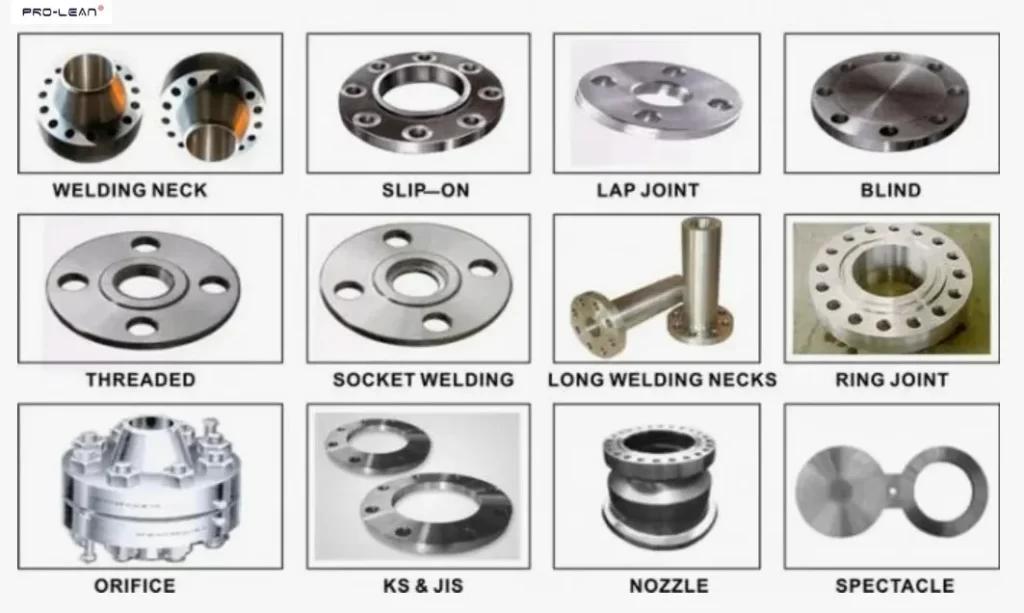
Basic Flange Types Overview
A flange is a mechanical part that makes a joint between two components. It connects sections of pipe or equipment using bolts and gaskets to create a tight, leak-proof seal.
Such flanges are commonly used where a reliable connection is required that still remains reliable for maintenance or inspection. Flanges provide a modular system that is easier to control, especially in high-pressure or high-temperature applications.
You’ll see flanges used in:
- Industrial piping systems
- Oil and gas transport
- Plumbing setups
- Mechanical assemblies
- Automotive applications
What is a flange, in simple terms? It is one main part of how machines and systems are connected and securely kept in place.
Key Parts of Flange and Their Purpose
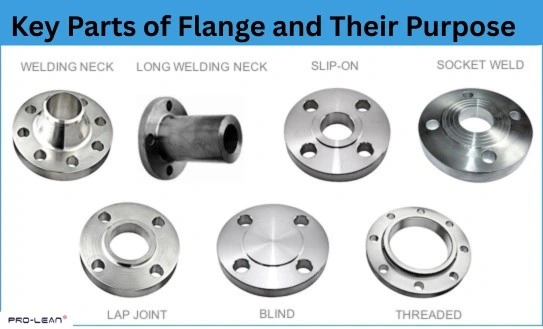
Flange Key Parts and Purpose
The design of every flange is similar. It has some essential features that enable it to perform its function.
Crucial flange parts include:
Flange face: This is a smooth surface that interfaces with other flange. It is where the gasket rests, aiding in sealing the joint.
Bolt holes: Holes around the rim where bolts pass through to hold flanges together.
Gasket surface: The inner surface of the flange, where the sealing element (gasket) sits.
Neck: In some types, like the weld neck flange, this offers extra support and distributes stress.
All these features contribute to the ability of the flanges to seal under pressure and keep systems leak-tight. So, precision in design and manufacture is essential.
Try Prolean Now!
What are the Different Types of Flanges?
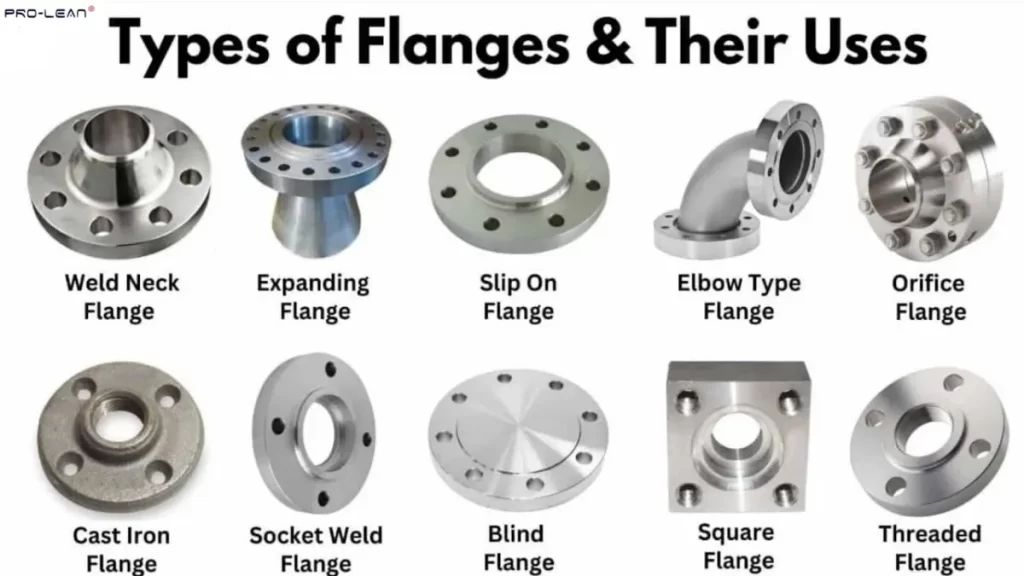
Types of Flanges and Uses
Not all flanges perform the same function. Various flanges are available based on the standards applied for pressure, alignment, and application.
Here are some various types of flanges:
Weld Neck Flange: This has a long, tapering hub, making it very suitable for high-pressure applications. It is welded on the pipe and offers great strength. It is ideal for high-pressure and high-temperature equipment systems, where strength is given special attention.
Slip-On Flange: As the name implies, it slips over the pipe and welds in. It is easy to install and cost-effective, typically used in low-pressure setups. It is inexpensive, easy to install, and widely used in low-pressure industrial setups.
Socket Weld Flange: This flange holds the pipe in a recessed area before welding. It is intended for high-pressure applications and smaller pipes. The compact design provides a tight seal and makes it ideal for use in high-pressure piping systems with small diameters̀ to save space.
Blind Flange: A solid flange that serves as a closure on the end of a pipe. Ideal for systems that intend to carry out future expansions or require pressure testing. It’s ideal for pressure testing, maintenance, or future expansions where the pipe might be reopened later.
Lap Joint Flange: Rotates with a stub end and works well in alignment. Best used in systems that will be regularly disassembled for service. This flange is ideal for systems frequently disassembled for cleaning or inspection purposes.
Threaded Flange: Attached to the pipe without a weld. It is applied in hazardous welding areas, such as explosive environments. It is used when welding is inapplicable or dangerous, such as flammable areas.
Slip-On Flange vs Weld Neck Flange – Which One is Best?
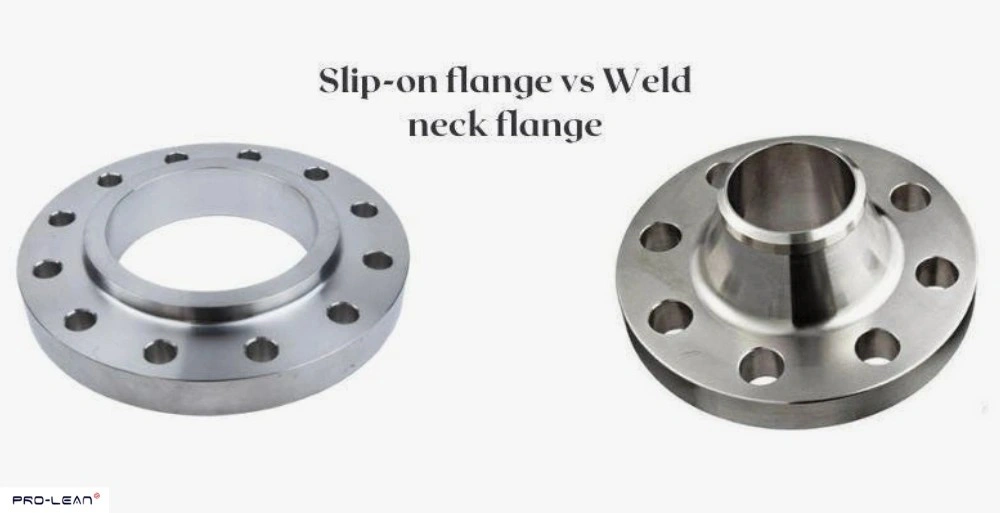
Slip-on vs. Weld Neck Flange
When comparing a slip-on flange vs weld neck flange, the choice depends on your system’s demands.
The slip-on flange is quite simple, cheaper, and easier to install. Ideal for systems concerning low pressure and temperature. A weld neck flange is built for strength.
It’s more expensive and requires welding, but it performs better in high-pressure systems, much like how CNC Milling vs CNC Turning can impact the final product.
| Feature | Slip-On Flange | Weld Neck Flange |
| Cost | Lower | Higher |
| Installation | Easier | More complex |
| Strength | Moderate | High |
| Pressure rating | Low to medium | Medium to high |
If durability and long-term performance matter more than cost, weld neck is the better choice.
Try Prolean Now!
CNC Machining for Flanges
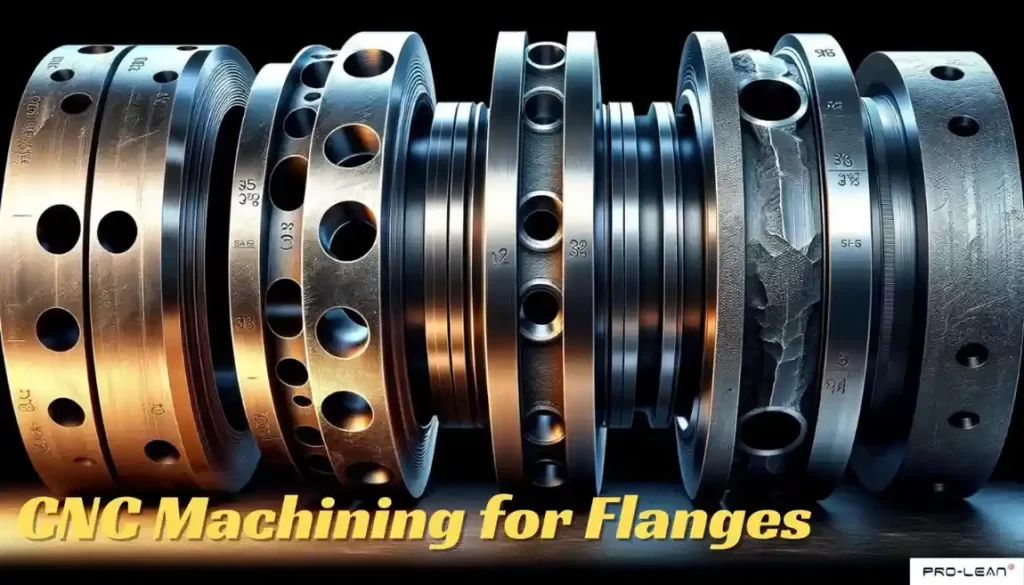
CNC Machined Industrial Flanges
Pretty much most of the time, you can’t use company screws by themselves because you need something just a little bit different. That’s where custom machining comes into play.
CNC machining can create flanges of the exact size and shape, specific bolt patterns, and fine tolerance requirements.
Some of the standard materials used in CNC machining for flanges include:
- Stainless steel
- Carbon steel
- Aluminum
- Brass
We select different materials according to the environmental conditions, pressure, and type of fluid involved. Steel is an excellent corrosion-resistant material of choice for chemical and marine applications.
CNC machining is at the heart of flange manufacturing today. With manual machining incapable of matching precision, CNC machining uses computer-controlled tools to drill, shape, and cut metal.

CNC Precision in Flange Manufacturing
The process ensures that every hole, edge, and thickness meets the specifications. Whether you’re producing one unit or thousands, the results stay consistent.
At Proleantech, our CNC machining service covers:
- Prototyping
- Low-volume production
- High-volume manufacturing
- Finishing and quality control
However, when it comes to CNC machining, precision is everything. Advanced CNC tools and software are essential for achieving the tight tolerances in CNC machining that modern applications demand.
We are even skilled in CNC milling or CNC turning, depending on the shape and structure of your part, whether it is milling for surfaces and holes or turning for the round or cylindrical components.
Why Choose ProleanTech?

ProleanTech for Customized Flange Solutions
We never sell just parts at ProleanTech; we supply precision solutions for flanges that precisely match the advanced requirements of your application. For Oil and Gas, Plumbing, Manufacturing, or Automotive, every project we undertake is customized to meet each industry’s specific standards and challenges.
Here’s why our clients trust us:
- Deep knowledge of flange machining
- Customized designs for specific industries
- Advanced CNC machining materials for top precision
- Fast turnaround without sacrificing quality
From the very first sketch and design concept to the last flange delivered, ProleanTech ensures that every flange is built to the standard of performing under pressure. Connect with us for precision, strength, and comfort.
Wrap Up
So, what is a flange? A flange is a crucial connector that keeps your mechanical systems sealed, safe, and easy to maintain. When you choose the correct flange and work closely with a trusted partner like ProleanTech, you don’t just get a product; you get peace of mind.
By producing finely machined flanges for safety enhancement, improved downtime, and long-term performance, we have served clients across an industry spectrum for years. With ProleanTech, you can always count on expert support, reliable service, and results to keep your systems running smoothly.
Want high-precision CNC Machining Service? Call ProleanTech now.
FAQs
Q1. What is the purpose of a flange?
A flange connects two parts of a system, like pipes or valves, to form a secure seal. It also makes it easier to take the system apart for cleaning or repairs. Without flanges, maintaining complex mechanical systems would be much more difficult.
Q2. What is a flange in machining?
In machining, a flange is a part shaped by processes like CNC milling or turning. It has been designed to fit precisely with other components, usually with bolt holes, sealing surfaces, and alignment features that ensure safety and performance.
Q3. What are the 3 most common flange types?
The most commonly used flanges are:
-
Weld neck flange for high strength and pressure
-
Slip-on flange for quick and easy installation
-
Blind flange for sealing the end of a pipe
These cover most needs in both industrial and plumbing systems.
Q4. How do I know which flange to use?
Start by considering your system’s pressure, temperature, and fluid type. Also, think about whether you need to remove the flange often. If unsure, speak to a machining expert or supplier like ProleanTech for recommendations.
Q5. What happens if a flange is too big?
An oversized flange will misalign, leading to improper sealing, leaks, and system damage. Precision drawing and CNC machining materials are utilized to maintain high-quality interferences with proper fit every time.
Q6. What are flanges in automotive?
Vehicle flanges are used in parts like exhaust systems, turbochargers, and coolant lines. These flanges need to handle heat, vibration, and pressure – hence, automotive flanges are often made using CNC precision machining.


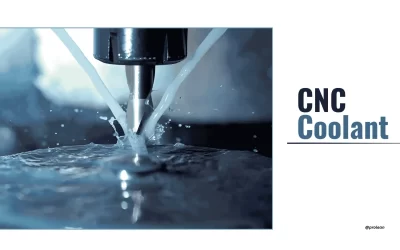

0 Comments